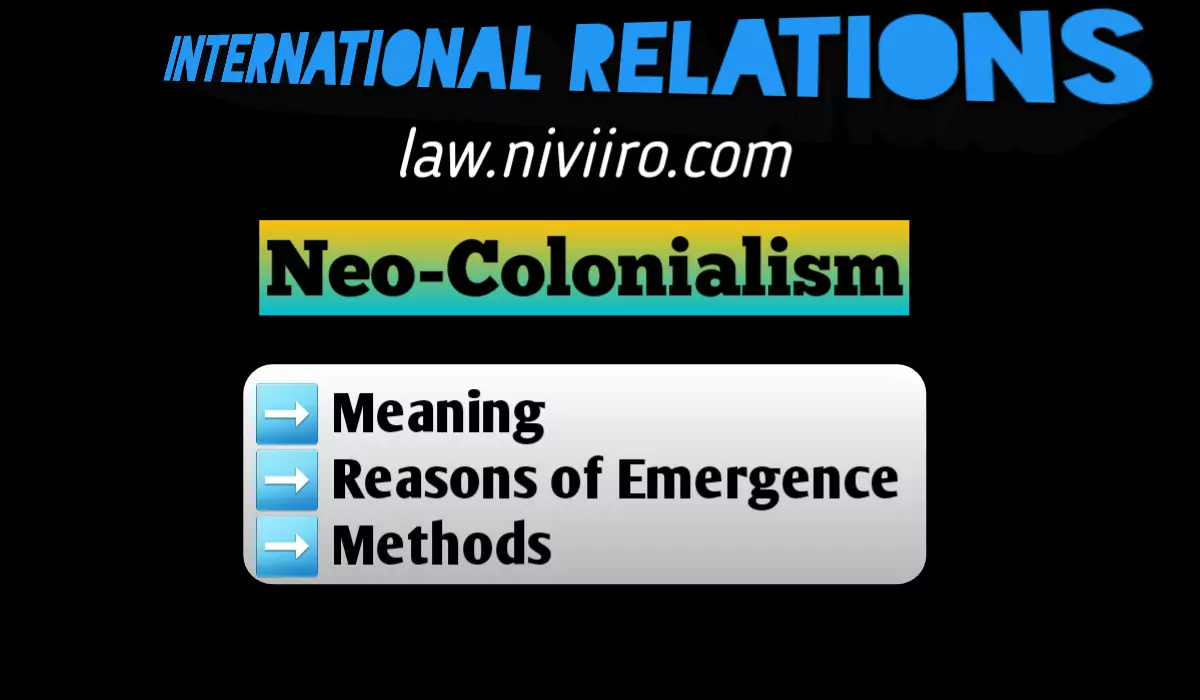Methods of Balance of Power – The Balance of Power is neither a gift of God nor an act of nature, but essentially a human contrivance for which the man has to work constantly.
To maintain balance of power, the following techniques are being used:
(i) Alliances and Counter-Alliances | Methods of Balance of Power
The alliance has been the component of the balance of power system that is most frequently deployed. It has been the customary tool to improve one’s position in relation to the opponent. This system predates all recorded state history. Morganthau says that “Alliances are necessary for functioning of the balance of power within a multiple state system.
The alliances may be defensive or offensive in nature, but they both seek to restrain a partner by limiting his political options and diverting him from a rival alliance that is accumulating military power “Every alliance is aggressive from the standpoint of the states that are opposed to it, and defensive from the standpoint of the states that participate in it.
An alliance has traditionally been used to bolster one state’s position of power while undermining another. Whereas an aggressive alliance aims to upset the balance of power in favour of its members, a defensive alliance works to restore it. The alliances, created out of necessity due to common goals, are centred on a common adversary. The alliances could disband when the objective has been accomplished.
A stable and long-lasting alliance must have the following elements: sufficient power to accomplish the goal, whether through aggression or defence; a shared interest between the allying states; a sound strategy; and factors such as geography, shared ideologies, similar cultures, complementary economies, etc. France formed alliances with the Czechoslovak Republic, Romania, Yugoslavia, Poland, and other nations during the interwar period, mostly to fortify herself against a potential threat from Germany.
Yet, alliances result in counteralliances. If an alliance is made against a state, no state can watch in silence. The Triple Entente (1907) between England, France, and Russia followed the Triple Alliance (1882) between Germany, Austria-Hungary, and Italy.
Similar to this, Germany formed alliances with Japan and Italy after World War 1 to balance out France’s agreements with a number of minor states. We observed the conflict between the Warsaw Pact of 1955 and the Atlantic Treaty Organization of 1949.
Alliances frequently spark suspicion and sometimes even start wars. The Axis alliance served as a check against France’s and East European countries’ alliance, which ultimately led to the Second World War.
(ii) Divide and Rule | Methods of Balance of Power
The oldest technique for maintaining the balance of power is this one. With this strategy, an attempt is made to keep the rival weak so that it cannot present a significant threat. It is possible to accomplish this by separating allies from the opposing group, coercing them into a posture of neutrality or isolation, or gaining their favour.
Between the 17th century and World War II, France used this strategy in an effort to keep Germany divided. In a similar vein, England has adopted this strategy in order to preserve the balance of power in Europe. Even Germany attempted to exploit the divisions between France and England during the interwar period.
(iii) Holder of Balance | Methods of Balance of Power
The balance of power shifts frequently as a result of changes in national power. As a result, balance must be maintained by the balancer, the balance holder, or the laughing third party. A nation or a group of nations plays the role of the holder of balance by providing temptations to the other equal parties so that each of the contending parties strives to obtain the support of the balancer while remaining detached from the rivalry of others. Ordinarily, the balancer stays out of it, but if one side becomes sufficiently stronger than the other side, the balancer joins the weaker side to restore the balance.
(iv) Compensations | Methods of Balance of Power
In the 18th and 19th centuries, compensation of a territorial kind was frequently used to maintain a balance of power. According to this strategy, certain regions are given to a weak country to bolster its power and weaken a strong state. Typically, this is carried out after a battle.
It is carefully considered while redistributing the territory to prevent undue strengthening of one power from disturbing the equilibrium. In order to maintain a balance of power between Russia, Prussia, and Austria, Poland was divided three times between 1772, 1793, and 1795.
The compensation technique was not well received by the peacemakers in Paris in 1919–20 and was not given much importance, but it nonetheless made an indirect appearance in the Treaty of Versailles. The new invention was the Mandate System, which allowed a region to be granted to a power in the form of trust. After the Second World War, this method was completely abandoned.
(v) Armament and Disarmament | Methods of Balance of Power
The finest method of national defence is military readiness. Building up one’s arsenal is the most obvious technique to obtain an advantage in power. This is true because in this game, war serves as the ultimate arbiter. Every time a country strengthens its armed forces, its adversaries also boost their armaments.
The fear of destruction has grown as a result of advances in science, technology, and military tactics. A state can strengthen its arsenal by either increasing domestic production or enlisting the military support of a more powerful state.
A state can maintain the balance of power by keeping the other power or powers disarmed. Disarmament, like armament, can also contribute to maintaining or destroying the balance of power. The method of compensating for territorial losses is somewhat comparable to the method of balancing the balance of power by proportionate weapons reduction.
Yet, actual disarmament efforts to keep the balance have fallen short. Regarding the reason for the failure of disarmament effort, Salvador de Maderiaga says, “The problem of disarmament is not the problem of disarmament. It is really the problem of the organisation of world community.” Disarmament, however, can also aid in keeping the balance of power.
A specific illustration of how disarmament can also be used as a tactic to maintain the balance of power is the partial disarmament in the nuclear realm brought about by the Partial Test Ban Treaty of 1963, Outer Space Treaty of 1967, Nuclear Proliferation Treaty of 1968, etc.
(vi) Buffer States | Methods of Balance of Power
Another strategy for maintaining the balance of power is buffer state construction. A buffer state is a neutral region positioned between two or more states that are playing the balance of power game. These states act as a buffer, especially when they are situated between two powerful nations. Afghanistan’s role as a buffer state between the British Empire and Russia in India is well known.
Similar to how Belgium and Holland functioned as a buffer between France and Germany, Poland served as a state between Germany and Russia. In the past, Tibet served as a barrier between China and British India.
Buffer states can play an honourable role as active members of one, two, or more aggregations of power, neutral or neutralised states, satellite or dependent territories, or dependent territories. The purpose of establishing such a buffer state between two huge, hostile nations is to keep the hostile large powers apart and lessen the likelihood of war between them.
(vii) Intervention and War | Methods of Balance of Power
When other tactics fail to work, war or intervention can also be utilised as a balance of power tool. Intervention is a dictatorial intrusion into the internal affairs of another nation to impose certain demands. Only a powerful state in relation to a weak state may employ this. Intervention is meant to bring in a supportive administration.
The goal of both the British intervention during the interwar period and the intervention of Germany and Italy in favour of France during the Spanish Civil War was to maintain the balance of power. Towards the close of World War II, Britain meddled in Greek affairs to prevent Greece from coming under Soviet control. Similarly, the USA intervened in Guatemala, Cuba, Lebanon, Laos, and Iraq to promote and protect its interests.
The ultimate form of involvement is war. Similar to intervention, “non-intervention” is a political strategy. Small states and those large powers that are content with the political order and have the option of using peaceful means to maintain the balance typically adhere to the non-interventionist stance.
In extreme circumstances, war is also used to keep the balance of power. There is even room for a preemptive war to avert the threat of growing power centralization. In actuality, balance of power warfare have been waged in every conflict to yet. The development of a Supreme Power in any one nation is seldom tolerated for very long and results in a swift response in the form of a united resistance, as when France and Britain united to oppose Hitler’s rise to power in Germany. To counter the rising might of Germany and Japan, which threatened the balance of power, the USA also abandoned her traditional strategy of isolation and enlisted in the Second World War.
Related Post | Methods of Balance of Power
- Emerging trends in international relations
- Relation between RTI and democracy
- National Power | Definitions | Forms | Methods
- Nature and scope of International Relations
- Legal History Notes
- Political Notes
- RTI notes
- Law of Torts notes
Methods of Balance of Power ?
(i) Alliances and Counter-Alliances,(Methods of Balance of Power)
(ii) Divide and Rule,(Methods of Balance of Power)
(iii) Holder of Balance, (Methods of Balance of Power)
(v) Armament and Disarmament,(Methods of Balance of Power)
(vi) Buffer States,(Methods of Balance of Power)
(vii) Intervention and War.(Methods of Balance of Power)
Reference Books | Methods of Balance of Power
- J.C. Johari – International Politics
- H.J. Morgantheau – Politics among Nations
- International Relations in the 21st Century by Pant
- An Introduction to International Relations by John Baylis, Steve Smith and Patricia Owens.
- Raymond Aron – Peace and war a theory of International Relations
- Prem Arora – International Relations and foreign policy

















